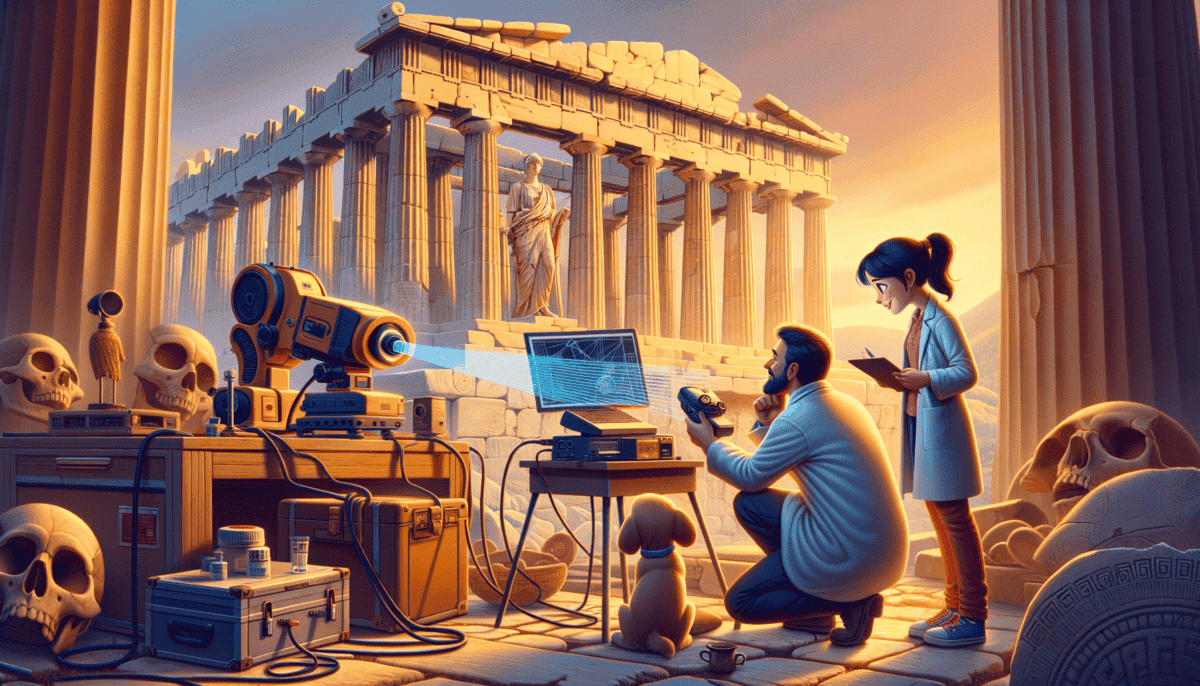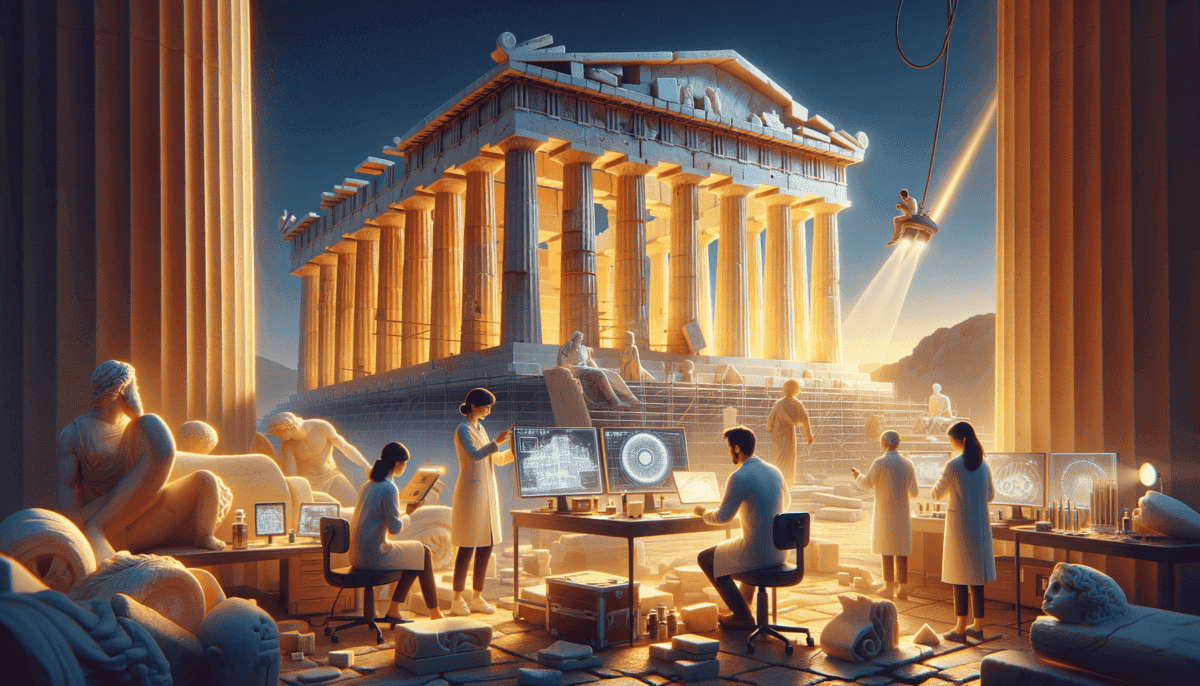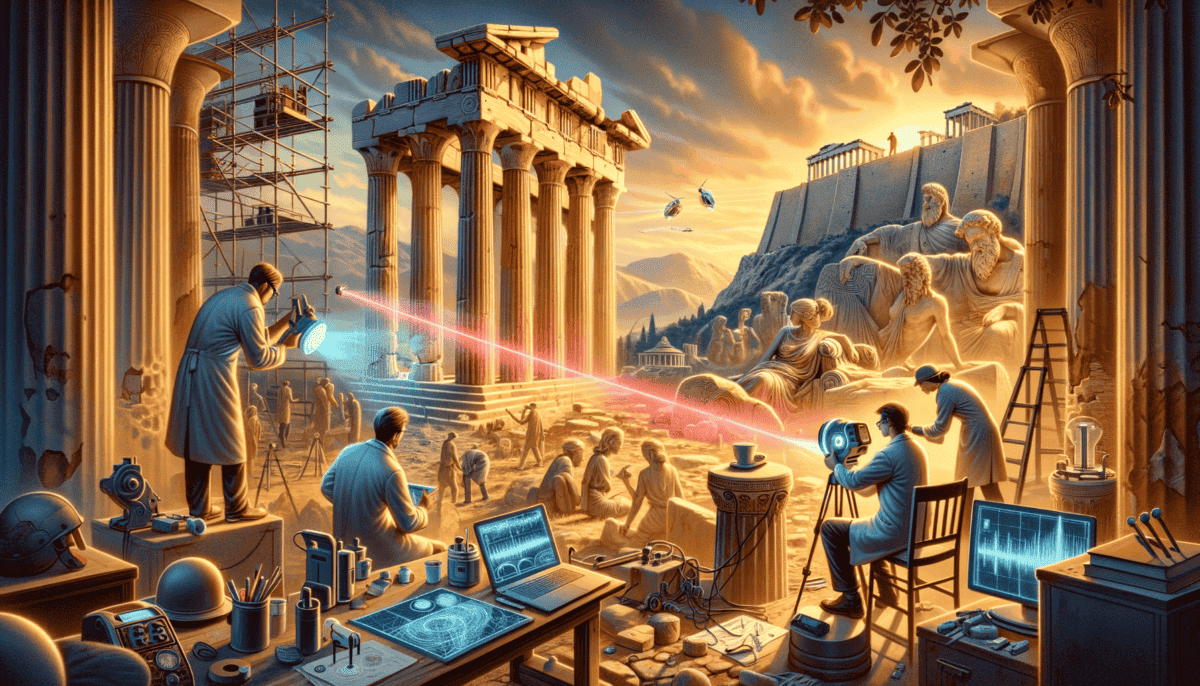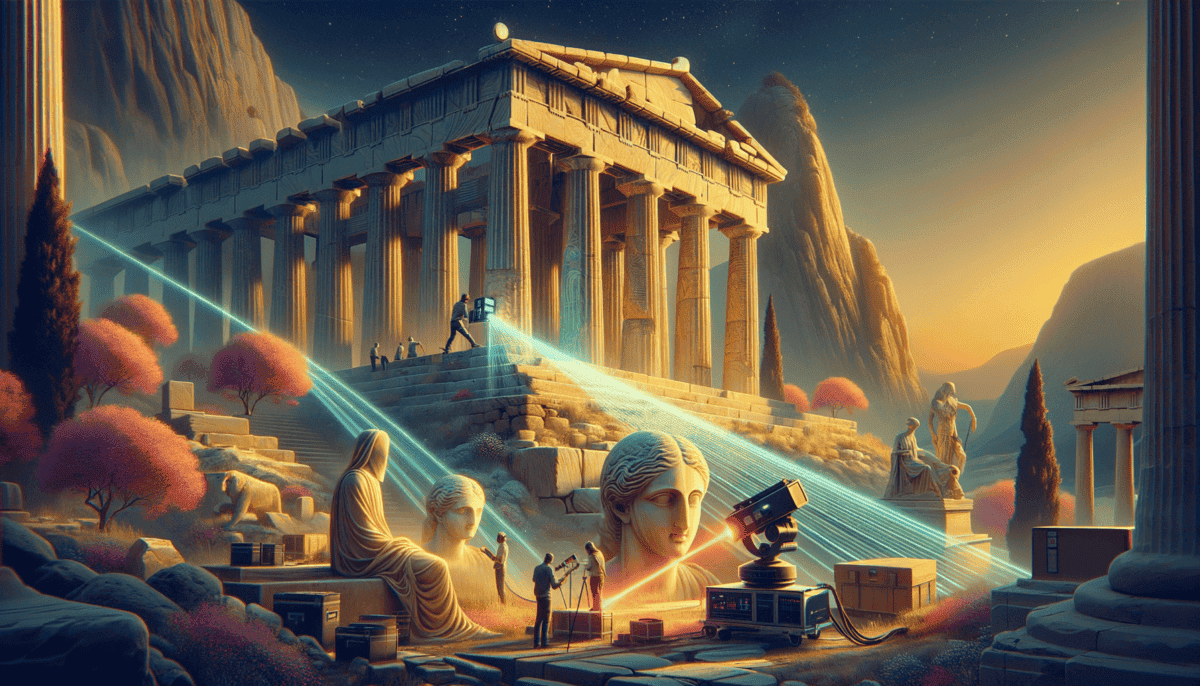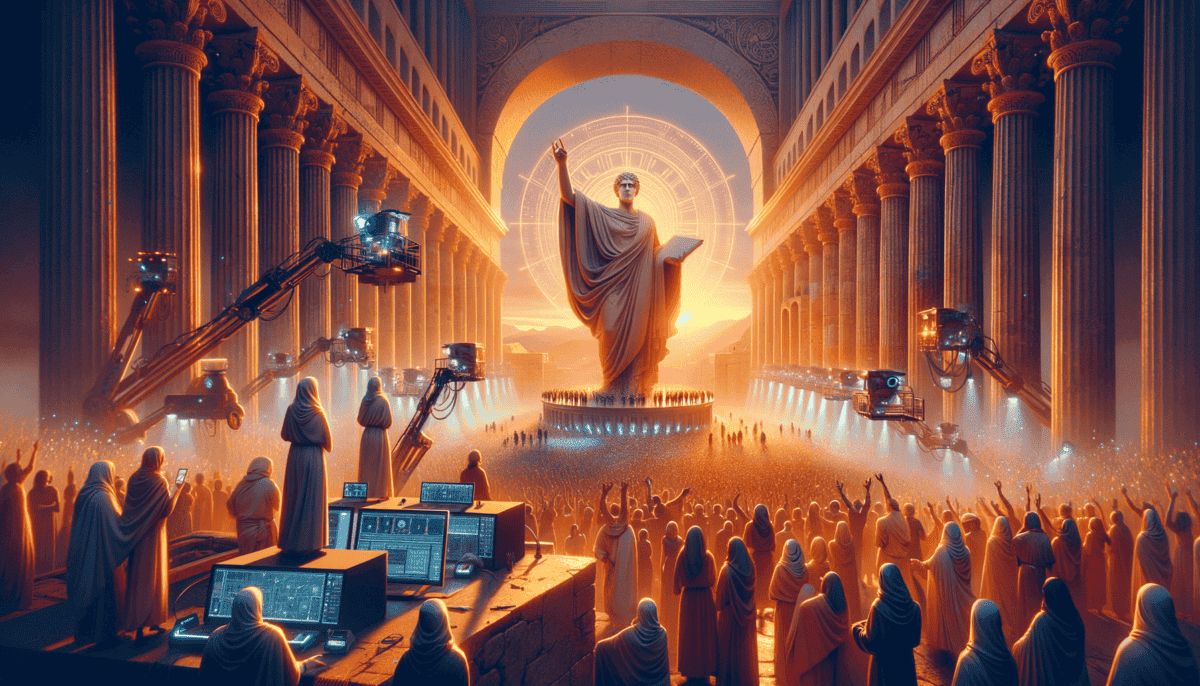The Whispering Stones
Sofia's footsteps echoed across the ancient stones of the Acropolis. The morning sun painted the marble columns golden, making them sparkle like magic. She loved being here early, before the tourists came.
"Look at this, Dr. Papadopoulos!" Sofia called out, pointing to a crack in one of the marble blocks. Her mentor walked over, his gray hair ruffled by the gentle breeze.
Dr. Andreas Papadopoulos knelt down, running his fingers along the damaged stone. His face showed worry. "This is exactly what I feared, Sofia. The stones are telling us something important."
"What do you mean?" Sofia asked, adjusting her red safety helmet. She had just started her job as a young archaeologist last month.
Dr. Papadopoulos pulled out his special camera. "These ancient buildings are like very old friends who need our help. See these tiny cracks? They're getting bigger because of rain, pollution, and even the ground shaking sometimes."
Sofia watched as he took pictures of the damage. The marble column had little holes and cracks that reminded her of the way ice cream melts on a hot day.
"But we can fix it, right?" Sofia asked hopefully. She loved these old buildings. They were like giant puzzles from the past.
"We can try," Dr. Papadopoulos smiled. "That's why we're here. We're like doctors for these ancient buildings. But instead of medicine, we use science to help them stay strong."
The Morning Discovery
They walked around the Parthenon, the biggest and most famous building on the Acropolis. Sofia carried their special tool bag, full of things that looked like toys but were actually important scientific instruments.
"Watch this," Dr. Papadopoulos said, pulling out a small device that looked like a TV remote. "This tells us how strong the stone is." He pressed it against the marble, and numbers appeared on its screen.
Sofia's eyes got big. "It's like magic! "
"It's science," he laughed. "But sometimes science can feel like magic. These tools help us understand what's hurting the buildings so we can protect them better."
• Cracks in the marble
• Crumbly stone surfaces
• Damage from rain
• Dark spots from pollution
As the sun climbed higher, more scientists arrived. They all wore matching orange vests and carried different tools. Sofia watched as they set up computers and strange-looking machines.
"Remember, Sofia," Dr. Papadopoulos said, putting his hand on her shoulder, "these buildings have stood here for thousands of years. They've seen kings and queens, wars and peace, rain and sunshine. Now it's our turn to help them stay strong for many more years."
A cool breeze carried the smell of wild herbs from the hills. Sofia looked up at the huge columns reaching into the blue sky. She felt proud to be part of this important work.
"Dr. Papadopoulos," she said suddenly, "I think I hear them!"
"Hear what?"
"The stones whispering! They're telling us their stories!"
He smiled warmly. "That's exactly right, Sofia. And we're going to make sure those stories continue for a very long time."
The morning light grew stronger, making the ancient marble glow. More scientists arrived with their tools, ready to begin another day of protecting these incredible buildings. Sofia couldn't wait to learn more about how they would use modern science to save these ancient treasures.
Modern Magic and Ancient Stones
The next morning, Sofia arrived at the Acropolis carrying a shiny silver case. Dr. Papadopoulos had promised to show her something amazing.
“Is that the special laser?” Sofia asked excitedly. Her eyes sparkled like the morning dew on the marble steps.
“Yes, it’s our newest tool,” Dr. Papadopoulos smiled, carefully opening the case. Inside was something that looked like a fancy flashlight. “This laser helps us clean the marble without hurting it.”
“Can I try it?” Sofia asked, bouncing on her toes with excitement.
“First, we need our safety gear,” Dr. Papadopoulos said, handing her special glasses that looked like something a superhero might wear. “Safety first!”
Learning New Tools
Dr. Papadopoulos showed Sofia how to hold the laser tool. “Very gentle, like holding a baby bird,” he explained. When they turned it on, a bright beam touched the dirty marble.
“Look!” Sofia gasped. Where the laser touched, the gray dirt disappeared, revealing clean, white marble underneath. “It’s like magic!”
“It’s science,” Dr. Papadopoulos winked. “But you’re right – it does feel magical.”
“The laser is like a tiny spotlight that makes the dirt jump away from the stone,” Dr. Papadopoulos explained. “It’s so gentle that it doesn’t hurt the ancient marble at all.”
Next, they used a special camera that could see inside the stones. It looked like a tablet computer, but showed rainbow-colored pictures of the marble.
“These colors tell us where the stone might be weak,” Sofia learned. “Blue means strong, red means we need to help that spot.”
Old Meets New
More scientists arrived with other cool tools. One had a flying drone with cameras that took pictures of the whole building from above. Another used a computer that could make 3D pictures of the temples.
• Cleaning lasers
• Special cameras
• Flying drones
• 3D computers
• Smart sensors
“Some people think we should only use old tools to fix old buildings,” Dr. Papadopoulos said. “But new tools can help us do an even better job of protecting these special places.”
Sofia watched as a scientist used a tiny robot to climb up a tall column. “The robot can look for damage in places we can’t reach safely,” she explained to a group of visiting students.
“You’re becoming quite the teacher,” Dr. Papadopoulos smiled proudly.
“I love learning about all these new ways to help the old stones,” Sofia said. “It’s like being a doctor and a detective at the same time!”
As the sun climbed higher, more tourists arrived to see the ancient temples. Sofia noticed how they pointed at the scientists working with their high-tech tools.
“We’re showing everyone that science and history can work together,” Dr. Papadopoulos said. “The past and future helping each other.”
Sofia nodded, carefully putting away the laser tool. She couldn’t wait to learn what other amazing machines they would use tomorrow to help save these ancient treasures.
Piecing Together the Past
Sofia stood before the mighty Parthenon, looking up at its towering columns. Today was special – they would start putting broken pieces back together! ️
“It’s like the biggest puzzle in the world,” she said to Dr. Papadopoulos.
“And each piece weighs as much as a car!” he laughed. “Look at this piece here.” He pointed to a broken chunk of marble bigger than Sofia.
Team Power
A big group of helpers gathered around them. There were scientists in white coats, builders in hard hats, and computer experts with laptops.
“How do we know which pieces go where?” Sofia asked.
“Watch this!” said Maria, the computer expert. She showed Sofia a screen with a 3D picture of the temple. “We scan each broken piece and the computer helps match them up.”
“It’s like having X-ray vision to see how the temple looked 2,500 years ago!” Sofia exclaimed.
Careful Work
A giant crane slowly lifted a marble piece into the air. Everyone watched closely. The piece had to fit just right.
“Slow… slower…” Dr. Papadopoulos called out. “Perfect!”
Sofia held her breath as the piece settled into place with a soft ‘click’. Everyone clapped!
Sofia learned that special metal rods help hold the pieces together. These rods are made of a special metal that won’t rust or hurt the marble.
History’s Helper
“Look what I found in this old book,” Dr. Papadopoulos showed Sofia a yellowed page. It had drawings of the temple from long ago.
“These old pictures help us know how to put it back together right,” he explained. “We’re like time travelers, talking to the people who built it first!”
The team worked carefully all day. Each piece they fixed made the temple look a little more like it did long ago.
• Scan broken pieces
• Check computer matches
• Clean contact points
• Add support rods
• Lift and place carefully
“Sofia,” called Maria, “Want to help me match some pieces on the computer?”
Sofia spent the afternoon helping find matches. It was like playing a video game, but the pieces were real temple parts!
“You’re getting really good at this,” Maria smiled. “Maybe you’ll be a computer expert AND an archaeologist!”
As the sun started to set, Sofia looked at their work. The temple seemed to glow in the orange light. One more piece of history was back where it belonged.
“Tomorrow we tackle the hardest pieces,” Dr. Papadopoulos said, patting Sofia’s shoulder. “Are you ready for an even bigger challenge?”
Sofia nodded eagerly. She couldn’t wait to help solve more pieces of this ancient puzzle.
Nature’s Battle
Dark clouds gathered over the Acropolis. Sofia and Dr. Papadopoulos rushed to cover the exposed marble pieces. Rain was coming – but this wasn’t just any rain. ️
“Quick, Sofia! The acid rain can hurt the marble!” Dr. Papadopoulos called out.
The Enemy Above
Sofia helped spread special waterproof covers over the ancient stones. Her friend Maria ran up with weather readings on her tablet.
“The pollution levels are high today,” Maria said, frowning at her screen. “The factory smoke mixes with rain and makes it extra harmful.”
“It’s like the sky is crying tears that can hurt our temple,” Sofia said sadly.
Shaky Ground
Suddenly, the ground trembled. Little pebbles danced on the marble floor.
“Everyone stay calm!” Dr. Papadopoulos shouted. “This is why we’re building the special earthquake protectors!”
Sofia watched as engineers worked on their newest invention – special bases that could help the columns stay strong during earthquakes.
“The bases work like shock absorbers on a bicycle,” explained Engineer Tom. “They help the building bounce instead of break!”
Smart Solutions
Dr. Papadopoulos showed Sofia their new tools:
• Tiny sensors that warn about dangerous shaking
• Clean air machines that protect the marble
• Strong but gentle supports for weak spots
“We’re like doctors,” Sofia realized. “But instead of helping sick people, we help sick buildings!”
Testing Time
The team tested their new earthquake base. They put a small column on it and shook the ground.
“Look!” Sofia pointed excitedly. “The column is dancing but not falling!”
Dr. Papadopoulos smiled proudly. “This could save many ancient buildings around the world.”
Working Together
As the storm passed, Sofia helped check for any damage. The covers had worked – the marble was safe and dry.
“Nature is strong,” Dr. Papadopoulos said, “but we are clever. When we work together, we can protect these special places.”
Sofia looked up at the temple, now gleaming in the fresh sunlight. “Take that, acid rain!” she declared.
That evening, Sofia wrote in her diary: “Today we fought against rain, pollution, and earthquakes. Sometimes the biggest enemies can’t be seen. But science helps us win!” ⚡
Tomorrow would bring new challenges. But Sofia knew that with their smart tools and teamwork, they could face anything nature threw at them.
The Time Chase
Sofia stared at the crumbling marble piece in her hands. Time was their biggest enemy now.
Money Troubles
“We need more special tools,” Dr. Papadopoulos said, looking worried. “But they cost a lot of money.”
Sofia watched as scientists from different countries arrived at the Acropolis. They came to help save the monuments.
“Look at all these helpers!” Sofia smiled. “They speak different languages, but they all want to save our temples.”
Working Fast
“Every minute counts,” Dr. Papadopoulos reminded the team. “These stones have waited 2,500 years. They can’t wait much longer.”
Sofia worked extra hard. She helped test new ways to protect the marble:
• Tiny robots that check for cracks
• Super strong glue that holds pieces together
• Smart computers that track damage
Big Discovery
One morning, Sofia made an exciting find.
“Dr. Papadopoulos! Look at this!” she called out. “The new coating works better if we warm it up first!”
“Sofia, you’re a genius!” Dr. Papadopoulos hugged her. “This will save us so much time!”
Team Power
Scientists from Japan brought special earthquake sensors. German experts shared new cleaning tools. Greek workers knew the temples better than anyone.
“It’s like a big puzzle,” Sofia said. “Everyone brings a different piece to help.”
Racing Forward
The days flew by fast. Sofia barely had time to eat lunch. But seeing the temples get stronger made her happy.
“Look how much we’ve done!” Maria pointed to their progress chart. “The temples are getting better every day!”
Dr. Papadopoulos gathered everyone together. “We’re doing great work. But winter is coming. We must work faster!”
Hope Shines
That evening, Sofia walked around the Acropolis. The setting sun made the marble glow orange. ☀️
“We won’t let you down,” she whispered to the ancient stones. “Science and teamwork will keep you safe.”
As stars appeared overhead, Sofia knew tomorrow would bring new challenges. But with friends from around the world helping, anything was possible.
In her diary that night, Sofia wrote: “When people work together, amazing things happen. The old temples teach us this – and now we’re teaching the temples how to stay strong!”
A New Dawn for Ancient Stones
The morning sun sparkled on the marble of the Acropolis. Sofia smiled as she watched workers carefully place the final protective shield over a restored column.
Victory Dance
“We did it!” Sofia jumped with joy. “The temples are safe now!”
Dr. Papadopoulos grinned proudly. “Thanks to science and teamwork, these monuments will stand for many more years.”
The special tools they used worked like magic:
• Laser cleaners made the marble shine
• Smart computers watched for tiny cracks
• Special coatings kept the rain away
• Strong supports protected against earthquakes
World Celebration
“Look who’s here!” Maria pointed excitedly. TV crews and reporters from many countries came to see their work.
“This is the biggest breakthrough in monument protection ever!” a reporter said. “Scientists from all over helped save these ancient temples!”
Special Honor
Sofia couldn’t believe her eyes when she saw her name in the newspaper. Her discovery about warming the protective coating had helped save months of work!
“You’ve shown us that new ideas can help save old treasures,” Dr. Papadopoulos told her.
Future Dreams
That evening, Sofia walked through the Acropolis one last time. The marble glowed in the sunset, strong and beautiful. ✨
“Hello, old friends,” she whispered to the temples. “Now you’re ready for another 2,500 years!”
Dr. Papadopoulos joined her. “Sofia, want to help protect monuments in Egypt next?”
Sofia’s eyes lit up. “Yes! There are so many amazing places we can save with science!”
Lasting Lessons
That night, Sofia wrote in her diary: “The temples taught me something important. When we mix old wisdom with new ideas, magical things happen! “
The ancient temples stand tall and proud now. They tell stories of the past, and thanks to science and caring people, they’ll share these stories with many more children in the future.
As stars twinkled above the Acropolis, Sofia knew this wasn’t the end. It was just the beginning of using science to protect history’s greatest treasures. Tomorrow would bring new adventures, new monuments to save, and new ways for science to help tell old stories.


